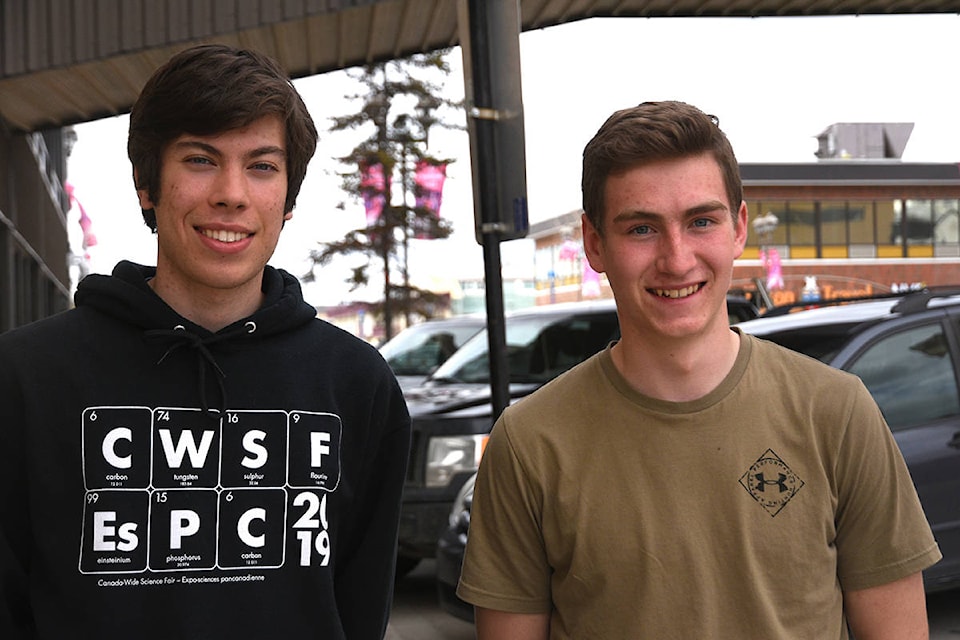The scientific achievements of two Whitehorse students are being celebrated at a national level.
Gavin Howells and Bruce Porter each received medals for the projects they submitted to the 2021 Canada-Wide Science Fair.
Porter, a Grade 10 student at F.H. Collins Secondary School, received a bronze medal in the intermediate (Grades 9-10) category for his project, Microplastic in Lake Fishes of Southern Yukon and Northern Stikine: A Baseline.
Howells, who is in Grade 11 at Vanier Catholic Secondary, was awarded a gold medal for his work, A Novel Evaluation of the Mutagenicity of E-cigarette Liquid and Vapour on Yeast Cells. His project was one of 10 selected for a gold medal out of numerous applicants. Howells is the first student from the Yukon to receive a gold medal in the senior (Grades 11-13) category.
Both students had previously entered projects into the Canada-Wide Science Fair. This year’s fair was held virtually due to the COVID-19 pandemic with awards being announced in an online ceremony on May 14.
Research and experiments
Porter said a goal of his project was to challenge Yukoners’ idea that they live in a pristine place unaffected by environmental pollution.
His research focused on the stomachs of 66 fish, which came from two lakes in the southern Yukon and three lakes around Atlin, B.C. The majority of the fish were lake trout, with some lake whitefish and arctic grayling.
With the assistance of a local scientist, Porter dissected the fish stomachs and found that about 30 per cent of the stomachs sampled contained microplastics.
Porter said most of the microplastics found in his survey appeared to be fibres originating from textiles.
The work was an expansion of a previous project on microplastics that Porter did where he found traces of the plastics in tap water, snow and river water.
His survey found more microplastics in the fish from the Yukon lakes when compared to the B.C. lakes. Porter said he has no way of explaining this, as the human use of all the lakes is similar, but that he would be interested in seeking an explanation in the future.
Howells exposed yeast to e-cigarette liquid and vapour for his experiments.
To test exposure to the vapour, he designed an exposure chamber built from sealed Tupperware, which used a large syringe to draw vapour from the e-cigarette, simulating a lung.
His experiments used a low-powered e-cigarette with both raspberry-flavoured and unflavoured liquid. Neither liquid contained nicotine.
He found that exposure to both the liquid and the vapour caused statistically significant increases in the frequency of mutations when compared to control groups, he said this suggests that vaping may have some ability to damage DNA or cellular processes in a way that could lead to mutations.
Applied science
Both young men have envisioned ways their work can be applied to benefit the community.
Howells presented his findings on the potential harm of e-cigarette vaping to 15 schools in an attempt to raise awareness. He said he first became interested in the topic when he noticed many of his peers vaping in Grade 8 and 9.
“There was kind of this misconceived notion that it was just water vapor and there were no health effects, because probably, it was advertised as better than smoking,” he said.
After reading some existing studies, Howells decided he wanted to add to the body of research on the effects of vaping.
Porter worked to develop a method of monitoring for microplastics that he says could be easily replicated in small communities with little in the way of resources or lab space. He hopes that community-based monitoring can help to better understand the situation regarding microplastics in the Yukon.
“We’re going to need a lot more monitoring to see what’s actually going on here, because I believe that most of the microplastics are coming from other sources, and being blown in through the atmosphere and landing in the Yukon. And we’re not really contributing that much,” he said.
Both Porter and Howells had been to the Canada-Wide Science Fair in person in the past. While they appreciated the opportunity to present their research virtually at the 2021 fair, the interaction with their peers through computer screens only made them eager for a return to browsing others’ research in person.
“It’s a much more engaging experience. You really feel the community a lot more than sitting at home,” Porter said.
They also missed the trading of commemorative pins, which is usually a feature of science fair socializing. They said pins from the Yukon are sought after and highly valued.
Both medal-winners hope to continue learning about the fields their science fair projects covered.
Porter said his project helped him gain skills in the environmental science field and he would like to continue with that in the future.
Howells said he remains interested in microbiology, particularly how it relates to disease prevention and treatment.
Contact Jim Elliot at jim.elliot@yukon-news.com
